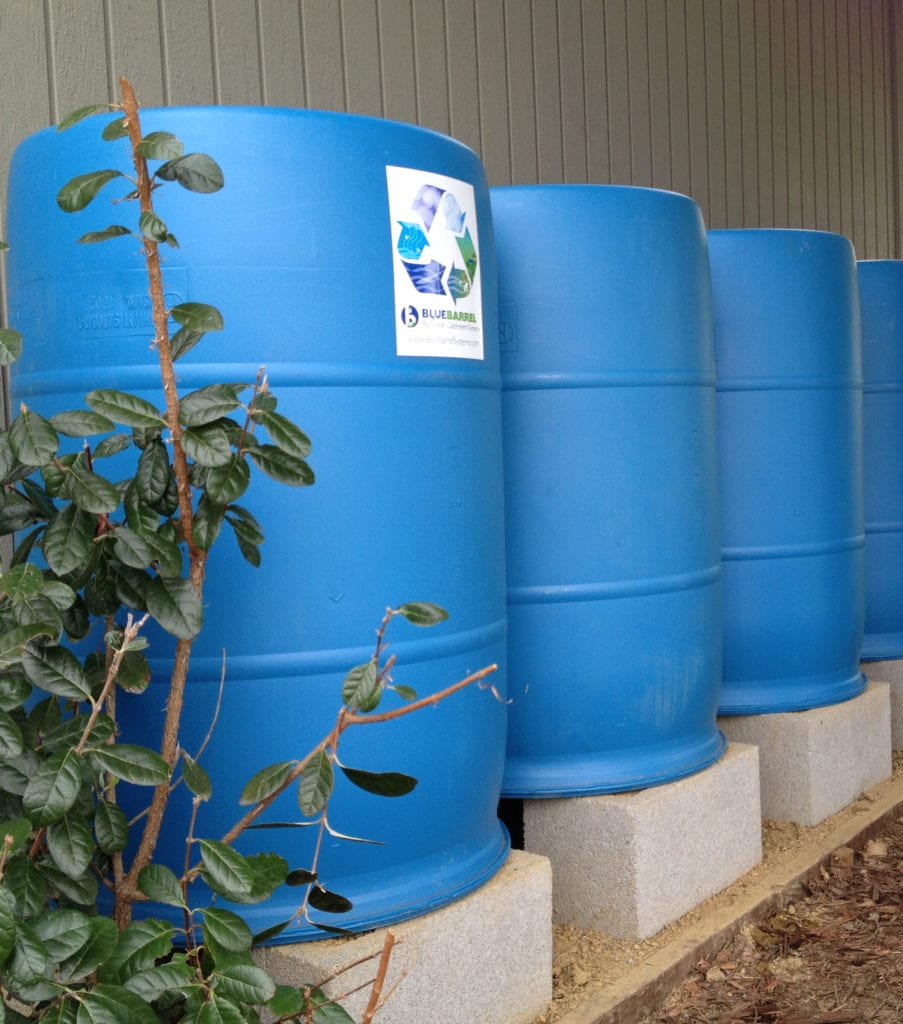by Jesse Savou
Reprinted with permission from BlueBarrelSystems.com.
It might not come as a surprise that there’s no water plants love better than rainwater. Imagine your thirsty plants doused in droplets fallen fresh from the sky, their leaves expertly channeling the bounty down stalks and into the soil—right to the root zone where it is needed most.
 Why is rainwater such a preferred water source? There is more than just one reason—in fact there are four:
Why is rainwater such a preferred water source? There is more than just one reason—in fact there are four:
-
Rainwater is 100% soft water. Free of the salts, minerals, treatment chemicals, and pharmaceuticals that are found in municipal water, groundwater, and surface water, rainwater is pure hydration. Salts and chemicals build up in your soil over time and these residues are tough on plants. This effect is exaggerated in potted plants where the accumulation is more pronounced. Rainwater can help flush these chemicals away and refresh the health of your soils.
- Rainwater is slightly acidic—naturally! Green gardeners know that most organically grown plants prefer soil pH levels between 5.5 and 6.5. This is on the acidic side of the neutral pH 7, and by nature’s design, it is the exact pH range for rainwater. City water, on the other hand, is treated to be alkaline to protect metal pipes from corroding, and can have a pH level upwards of 8.5. Greywater (once-used household water from a laundry machine, shower, or bathroom sink) will start with the same pH as your tap water, but can have a pH as high as 10.5 once it gets to the garden depending on the types of soaps and detergents that are in it. Irrigate with rainwater to flush out your soil and help keep your soil pH in perfect balance ongoing!
-

This 6-barrel BlueBarrel Rainwater Catchment System™ irrigates a water-wise front yard with a gravity-fed drip irrigation line.
Stored rainwater contains some organic matter. If collected from your rooftop, rainwater contains traces of organic material. While the water is very clean and should run clear, it has been exposed to anything on your roof. We’re not talking about chunks (these get pre-filtered out on their way into properly-designed rain barrels)–we’re just talking about contact exposure to leaf litter, pollen, bird droppings and the like (which perhaps not surprisingly are great for your plants). A rain barrel hosts a beneficial biology to keep the water alive – literally. It’s like a light application of fertilizer every time you water.
- Rain contains nitrates—an important macro-nutrient. Rainwater contains nitrate – the most bio-available form of nitrogen. Nitrogen is one of the three key macro-nutrients that plants need to thrive – necessary for the development of lush foliage. Many forms of nitrogen are not actually able to be absorbed by plants. Nitrates, which are made up of nitrogen and oxygen, are formulated by nature for maximum uptake by your plants. Plants typically absorb most of their nitrates from the soil. And where do those nitrates come from? Rain!
On a personal note, before I discovered rainwater, I doubted I would ever be able to keep a house plant alive. I had somewhat better luck outdoors in the garden, but little did I know that the potted plants were really suffering from the salt, chemical, and mineral buildup of tap water, and the high alkalinity. Then I learned about watering with rainwater. Rainwater straight from my rain barrels into a watering can is what I use for my potted plants and nursery starts. A gravity fed drip line allows me to apply rainwater directly to my in-ground garden with no effort at all. And what a difference it makes. Suddenly I have a green thumb… but (shhh, don’t tell…. rather, tell EVERYBODY!) the secret is the water.
Plant health is just one of the many benefits of harvesting rainwater. Click here for a handful of other great reasons to collect the rain that falls on your roof!

Two multi-barrel BlueBarrel Rainwatwer Catchment System™ setups maximizes rainwater storage at this home.
About the Author
Jesse Savou is founder/owner of BlueBarrel Rainwater Catchment Systems. She earned degrees in Linguistics and Spanish at Stanford before making a career shift which led her to a master’s program in Ecological Design at the Conway School in western Massachusetts. After building her first rainwater collection system as a post-grad school AmeriCorps project, Jesse launched BlueBarrel and earned her professional accreditation from American Rainwater Catchment Systems Association (ARCSA). Also a certified Permaculture Designer, graduate of the Ecosa Institute’s intensive course in Sustainable Design, and Fellow of Sonoma County’s Leadership Institute for Ecology & the Economy, Jesse understands rainwater harvesting as one of many measures to bring our households into balance with the earth’s capacity to thrive.
Each author appearing herein retains original copyright. Right to reproduce or disseminate all material herein, including to Columbia University Library’s CAUSEWAY Project, is otherwise reserved by ELA. Please contact ELA for permission to reprint.
Mention of products is not intended to constitute endorsement. Opinions expressed in this newsletter do not necessarily represent those of ELA’s directors, staff, or members.



